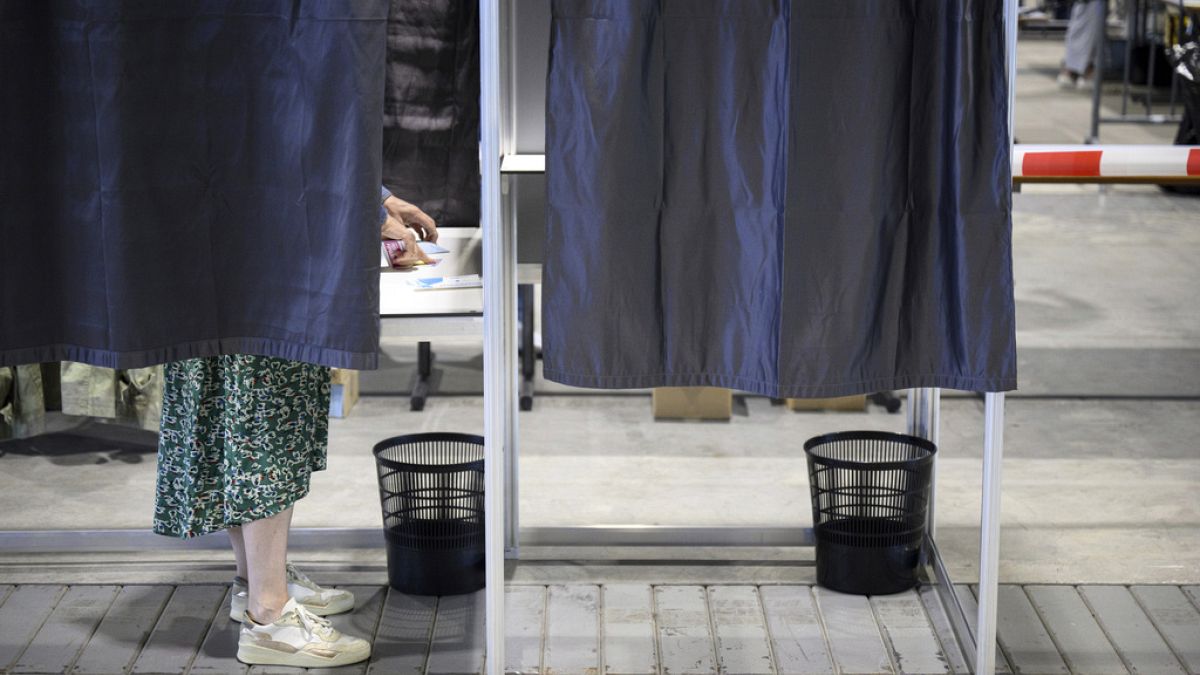Montana
Native Americans in Montana Challenge New Gender Law

A new law in Montana that went into effect last month rigidly defines sex in ways that Indigenous Two-Spirit Native Americans say violate their religious and cultural rights. CNN breaks down how Senate Bill 458 affects that community, and how they’re pushing back against it. A little background: Gov. Greg Gianforte signed the bill in May, legally defining sex as either male or female based on an individual’s XX or XY chromosomes and reproductive organs, per the Montana Free Press. The ruling influences dozens of parts of state code, including driver’s licenses, demographic records, and anti-discrimination laws. The Missoulian Two-Spirit Society has now joined a lawsuit challenging the law.
“We don’t ascribe to just simply biologic definitions,” says David Herrera, co-founder and executive director of the group. “We acknowledge that there are different genders, and our cultures have always known that there are more than two genders.” The Missoulian explains that “Two-Spirit” is an umbrella term referring to Indigenous people who have both a masculine and a feminine spirit. Historically they were assigned spiritual roles in ceremonies and in healing practices, roles of great importance. Indigenous scholar Kalpana Jain writes in the Conversation that stories passed down by the Blackfeet “acknowledged and accepted individual gender expression and identity because it was granted by the divine. Personal gender identity was rarely questioned, because it was tantamount to questioning the divine.”
Herrera says Two-Spirit identities were seen as “an abomination” during colonization, and as tribes began assimilating, aggression toward LGBTQ people within Native communities grew. “We’ve already been traumatized through so many things that the government has done to us and so we just figured it’s time—we have to step up and reclaim what’s rightfully ours and not let the government take that away from us,” Steven Barrios, a co-founder of the Montana Two-Spirit Society, tells CNN. Per Montana Public Radio, plaintiffs in the case also include two intersex individuals, who say the new definition on the books fails to recognize their chromosomal differences, and a transgender Navy veteran. The state is expected to answer the lawsuit by mid-December. (Navajo Nation is grappling with gay marriage ban.)

Montana
With No. 1 seed in hand, Montana State now looks toward FCS playoffs

Following a 34-11 victory over rival Montana to clinch the outright Big Sky Conference championship, Montana State received the No. 1 overall seed for the upcoming FCS playoffs when the bracket was announced Sunday.
The Bobcats (12-0) have a first-round bye and will host either No. 16-seed New Hampshire or Tennessee Martin in the second round on Saturday, Dec. 7.
Montana State coach Brent Vigen spoke with the media after the Selection Sunday show on ESPN, which the Bobcats and their fans gathered to watch at Worthington Arena.
For a full recap from Sunday’s event at Worthington Arena, see the video player above.
Montana
Brawl of the Wild Replay: No. 9 Montana at No. 2 Montana State

BOZEMAN — Second-ranked Montana State was seeking regular-season perfection when it welcomed rival Montana to Bobcat Stadium on Saturday, Nov. 23, 2024.
The Bobcats entered the 123rd Brawl of the Wild with an 11-0 overall record with a chance to finish 12-0 for the first time in program history and also win the outright Big Sky Conference championship.
The ninth-ranked Grizzlies, meanwhile, were 8-3 and aiming to play spoiler for Montana State while also improving their own seeding for the FCS playoffs.
Watch a condensed replay of the game between No. 2 Montana State and No. 9 Montana in the video above.
Montana
‘Yellowstone’ highlights influence behind a changing Montana

The popular “Yellowstone” TV series, set and filmed in Montana, taps into a lesser-known chapter of the state’s history: its settlement by Confederates and ex-Confederates during and after the Civil War.
I come to this story with a unique perspective. I’m a fourth-generation Montanan. I’m also a scholar of U.S. Western literary and cultural studies and left the state in my 20s to pursue a career in academia.
Then, during the pandemic, I returned to Montana for a time to lead a statewide cultural organization that connects Montana’s history and literature to its modern-day residents.
That’s why, for me, the story of the show’s protagonist, John Dutton III, who heads a wealthy-but-embattled Montana ranching family, is not just a cultural phenomenon. Rather, “Yellowstone” offers insights into the dynamics that are currently influencing a changing Montana.
Montana’s little-known legacy
One of the series’ prequels, “1883,” provides the crucial backstory for the Dutton family’s journey to Montana.
James Dutton, portrayed by Tim McGraw, was a former Confederate captain; his wife, Maggie, was a nurse for the Confederate Army. In leaving behind their war-torn lives to seek new opportunities, they mirror the historical trend that saw Confederate settlers moving West during and after the Civil War.
According to Montana historian and scholar Ken Robison, Confederate prisoners of war languishing in Union prisons were paroled to western territories like Montana. By 1864, two such parolees had discovered gold in what is still called Confederate Gulch, at the time one of the largest settlements in Montana Territory. Other settlements, such as Dixie Town and Jeff Davis Gulch, dotted the landscape. Montana’s territorial capital was briefly called Varina, named after the Confederate president’s wife.
Although there is no way to know for certain, it’s possible that during the latter half of the war, half of Montana Territory’s residents — maybe 30,000 — were pro-secession. Some had been in Confederate service; the rest shared their sentiments.
After the war, many of those Confederates stayed. By the late 1800s, Montana was home to 13 United Confederate Veterans organizations totaling 176 members. In 1916, the Montana Chapter of the Daughters of the Confederacy erected a Confederate memorial in Helena, the state capital; it stood for a century. The 1920s saw the rise of about 40 Ku Klux Klan chapters across the state to promote xenophobic policies against immigrants and racist policies against nonwhites. Today, Montana remains one of the whitest states in the U.S. — about 85% of Montanans are white; less than 1% are Black.
Recasting the ‘Lost Cause’
Numerous historical echoes surface briefly in “Yellowstone.”
In Season 2, there’s a violent confrontation involving a militia group that displays Confederate and “Don’t Tread on Me” flags. This subplot speaks to Montana’s long history as a hub for populist and anti-government movements. The Southern Poverty Law Center reports that Montana has 17 hate and anti-government groups, which include three defined as white supremacist or neo-Nazi.
This depiction of militia groups in “Yellowstone” represents the broader history of populist resistance in the American West. From the Sagebrush Rebellion of the 1970s to the Montana Freemen’s standoff with federal agents in the 1990s, Westerners have often resisted federal control over land and resources — tensions that perhaps trace back to the Confederacy’s own secession, a resistance rooted in defiance of federal authority, particularly over slavery.
After the Confederacy’s defeat, the “Lost Cause” narrative, in an attempt to preserve Southern pride, recast the South’s secession as a fight for states’ rights, and not a defense of slavery.
Those Lost Cause connections reverberate through John Dutton III’s relentless battle to preserve his family’s ranch. Fighting overwhelming political and economic pressures, Dutton remains steadfast in his determination to hold onto the land, even when it goes against his best interests.
This tenacity reflects the Lost Cause mindset — a clinging to a nostalgia-tinged, yet unattainable, past. Dutton embodies the archetype of the “aggrieved white man,” a figure central to many populist movements, who feels displaced from his former position of power in politics, work and family life.
Populist contradictions
It’s hard to discern to what degree recent changes in Montana can be attributed to “Yellowstone.” What is certain: Today’s longtime Montana residents find themselves exposed to a fresh set of political, economic and cultural forces.
Tourism and the local economy are up, due in part to the “Yellowstone” effect. But so are concerns about the rising costs of most everything, particularly houses.
These trends have been spurred, in part, by outsiders moving to Montana — newcomers who romanticize the state’s hardscrabble past and what they perceive as its current rough-hewn lifestyle.
What’s more, Montana has morphed from a purple state known for its political independence into a reliably conservative stronghold.
The drastic shift from purple to red solidified in 2020 with the election of a Republican governor after 16 years of Democratic leadership. It was further underscored by the defeat of Democratic Sen. Jon Tester by Republican Tim Sheehy in the 2024 election.
In “Yellowstone,” as Dutton is sworn in as Montana’s new Republican governor, he tells his constituents that he is “the opposite of progress” in response to changes that outside influences are bringing to the state.
Yet the politics of “Yellowstone” are “hard to pin down,” and the Duttons themselves espouse various versions of left- and right-wing populism as they simultaneously battle and embody the political and economic elite.
By the same token, Montanans resent wealthy outsiders but have given them political power by voting them into office.
Montana’s current governor, Greg Gianforte, is a tech millionaire, originally from Pennsylvania; Sheehy, similarly, is a wealthy out-of-stater.
Neither one might approve of the fictional Gov. Dutton’s proposed policy of doubling property and sales taxes for out-of-state “transplants” — though many Montanans probably would. For some, the rapid changes of the past few years have been, like life for the Dutton family, a challenge.
Randi Lynn Tanglen served as professor of English at Austin College in Texas (2008-2020), executive director of Humanities Montana (2020-2022), and is currently vice provost for faculty affairs at the University of North Dakota (2023-present). She holds degrees from Rocky Mountain College, the University of Montana and the University of Arizona.
-

 Business1 week ago
Business1 week agoColumn: Molly White's message for journalists going freelance — be ready for the pitfalls
-

 Science5 days ago
Science5 days agoTrump nominates Dr. Oz to head Medicare and Medicaid and help take on 'illness industrial complex'
-

 Politics1 week ago
Politics1 week agoTrump taps FCC member Brendan Carr to lead agency: 'Warrior for Free Speech'
-
/cdn.vox-cdn.com/uploads/chorus_asset/file/25739950/247386_Elon_Musk_Open_AI_CVirginia.jpg)
/cdn.vox-cdn.com/uploads/chorus_asset/file/25739950/247386_Elon_Musk_Open_AI_CVirginia.jpg) Technology6 days ago
Technology6 days agoInside Elon Musk’s messy breakup with OpenAI
-

 Lifestyle1 week ago
Lifestyle1 week agoSome in the U.S. farm industry are alarmed by Trump's embrace of RFK Jr. and tariffs
-

 World1 week ago
World1 week agoProtesters in Slovakia rally against Robert Fico’s populist government
-

 News7 days ago
News7 days agoThey disagree about a lot, but these singers figure out how to stay in harmony
-

 News1 week ago
News1 week agoGaetz-gate: Navigating the President-elect's most baffling Cabinet pick



















